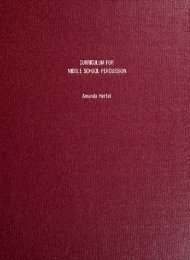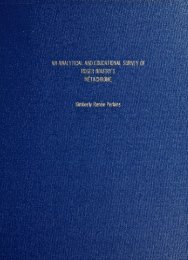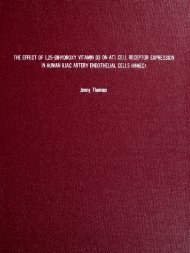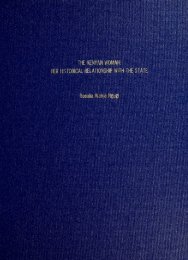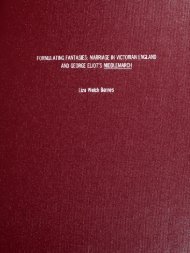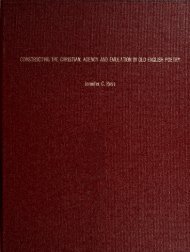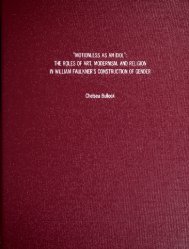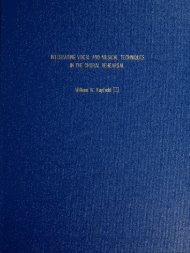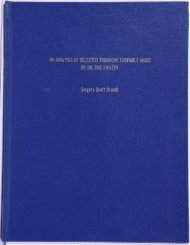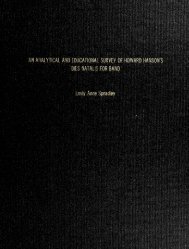The Effect of Aposematic Coloration on the Food Preference of ...
The Effect of Aposematic Coloration on the Food Preference of ...
The Effect of Aposematic Coloration on the Food Preference of ...
- No tags were found...
You also want an ePaper? Increase the reach of your titles
YUMPU automatically turns print PDFs into web optimized ePapers that Google loves.
<str<strong>on</strong>g>The</str<strong>on</strong>g> effect <str<strong>on</strong>g>of</str<strong>on</strong>g> aposematic colorati<strong>on</strong> <strong>on</strong> <strong>the</strong> food preference <str<strong>on</strong>g>of</str<strong>on</strong>g> Aphelocoma coerulescens, <strong>the</strong>Florida scrub jaybyMary Elizabeth HillA <str<strong>on</strong>g>The</str<strong>on</strong>g>sis Submitted in Partial Fulfillment <str<strong>on</strong>g>of</str<strong>on</strong>g>Requirements <str<strong>on</strong>g>of</str<strong>on</strong>g> <strong>the</strong> CSU H<strong>on</strong>ors ProgramFor H<strong>on</strong>ors in <strong>the</strong> degree <str<strong>on</strong>g>of</str<strong>on</strong>g>Bachelor <str<strong>on</strong>g>of</str<strong>on</strong>g> ScienceinBiologyCollege <str<strong>on</strong>g>of</str<strong>on</strong>g> Science,Columbus State University<str<strong>on</strong>g>The</str<strong>on</strong>g>sis Advisorfb*. C \f /U'^ll c£$( Date y/?*;/&5Committee Member^f*\' 7 ~-^fZT Date z»" Apr' 1 ?ea$Committee Member ^h^C- -\/CSU H<strong>on</strong>ors Committee Member ^y^^U^c^ ) , $u^J^Date V/"*- ^/OCoordinator, H<strong>on</strong>ors Program (J>c^A*c
Digitized by <strong>the</strong> Internet Archivein 2012 with funding fromLYRASIS Members and Sloan Foundati<strong>on</strong>http://archive.org/details/effect<str<strong>on</strong>g>of</str<strong>on</strong>g>aposematOOhill
Abstract<str<strong>on</strong>g>Aposematic</str<strong>on</strong>g> colorati<strong>on</strong>, comm<strong>on</strong>ly observed in noxious organisms, serves as a warning topredators to avoid attacking specific prey.This colorati<strong>on</strong> is c<strong>on</strong>spicuous in nature, with <strong>on</strong>e <str<strong>on</strong>g>of</str<strong>on</strong>g><strong>the</strong> most comm<strong>on</strong> examples being a red and black pattern.<str<strong>on</strong>g>The</str<strong>on</strong>g> plant Abrus precatorius exhibitsthis warning signal in its seeds, which resemble lady beetles and c<strong>on</strong>tain <strong>the</strong> c<strong>on</strong>centrated toxinabrin.Aphelocoma coerulescens, an endemic and federally threatened bird in <strong>the</strong> state <str<strong>on</strong>g>of</str<strong>on</strong>g>Florida, shares a similar distributi<strong>on</strong> with Abrus precatorius, making interacti<strong>on</strong> between <strong>the</strong> twospecies possible.Using an edible model <str<strong>on</strong>g>of</str<strong>on</strong>g> <strong>the</strong> Abrus seed, this potential interacti<strong>on</strong> was testedin Martin and Palm Beach County populati<strong>on</strong>s <str<strong>on</strong>g>of</str<strong>on</strong>g> Aphelocoma coerulescens by presenting a redand white seed to individual scrub jays to determine whe<strong>the</strong>r <strong>the</strong>y showed a preference for oravoidance <str<strong>on</strong>g>of</str<strong>on</strong>g> <strong>the</strong> red model seed.Results showed a significant tendency by <strong>the</strong> birds to preferwhite over red, indicating that <strong>the</strong> color, independent <str<strong>on</strong>g>of</str<strong>on</strong>g> o<strong>the</strong>r warning signals, functi<strong>on</strong>saposematically to discourage predati<strong>on</strong> <str<strong>on</strong>g>of</str<strong>on</strong>g> Abrus precatorius seeds.
Introducti<strong>on</strong>I. Descripti<strong>on</strong> <str<strong>on</strong>g>of</str<strong>on</strong>g> <str<strong>on</strong>g>Aposematic</str<strong>on</strong>g> <str<strong>on</strong>g>Colorati<strong>on</strong></str<strong>on</strong>g><str<strong>on</strong>g>Aposematic</str<strong>on</strong>g> colorati<strong>on</strong> is an interesting phenomen<strong>on</strong>, characterized by <strong>the</strong> c<strong>on</strong>spicuouscolorati<strong>on</strong> <str<strong>on</strong>g>of</str<strong>on</strong>g> potentially harmful or noxious organisms.Also called warning colorati<strong>on</strong>, thisunique patterning <str<strong>on</strong>g>of</str<strong>on</strong>g> external appearance serves to defend an organism through advertisement <str<strong>on</strong>g>of</str<strong>on</strong>g>its <str<strong>on</strong>g>of</str<strong>on</strong>g>fensive or hazardous traits (Speed 2000).Color as a defensive mechanism in nature isappealing to study because, though frequently observed, it is unusual in that it functi<strong>on</strong>s in avariety <str<strong>on</strong>g>of</str<strong>on</strong>g> seemingly opposing ways.For example, camouflage, or crypsis, <str<strong>on</strong>g>of</str<strong>on</strong>g> organismscomm<strong>on</strong>ly occurs as protecti<strong>on</strong> against predati<strong>on</strong> by blending <strong>the</strong> potential prey against itsnatural background.Unlike crypsis, however, aposematic colorati<strong>on</strong> and its generated protecti<strong>on</strong>rely <strong>on</strong> <strong>the</strong> obvious appearance <str<strong>on</strong>g>of</str<strong>on</strong>g> an organism against its background.Why have some organisms evolved this higher visibility?<str<strong>on</strong>g>The</str<strong>on</strong>g> answer lies in <strong>the</strong> functi<strong>on</strong><str<strong>on</strong>g>of</str<strong>on</strong>g> <strong>the</strong> l<strong>on</strong>g-term memory in predators (Speed 2000).When a predator comes in c<strong>on</strong>tact withunpalatable or harmful prey for <strong>the</strong> first time, it will likely have a nasty experience. To avoidrepetiti<strong>on</strong> <str<strong>on</strong>g>of</str<strong>on</strong>g> such incidents, it is helpful to <strong>the</strong> individual predator if it can remember somethingabout <strong>the</strong> prey to aid recogniti<strong>on</strong> in <strong>the</strong> future. C<strong>on</strong>versely, it is helpful to <strong>the</strong> survival <str<strong>on</strong>g>of</str<strong>on</strong>g> <strong>the</strong>whole prey species if <strong>the</strong> predator avoids future encounters; fewer prey will be removed from <strong>the</strong>gene pool.C<strong>on</strong>spicuous colorati<strong>on</strong> <str<strong>on</strong>g>of</str<strong>on</strong>g> <strong>the</strong> prey reinforces this avoidance learning in predators byproviding a memorable signal to associate with <strong>the</strong> experience.Future sightings <str<strong>on</strong>g>of</str<strong>on</strong>g> prey bearing<strong>the</strong> same, or even just similar, aposematic colorati<strong>on</strong> <strong>the</strong>n stimulate memory jogging in <strong>the</strong>predator, causing it to remember <strong>the</strong> previous encounter and avoid <strong>the</strong> prey (Speed 2000).II.Evoluti<strong>on</strong> <str<strong>on</strong>g>of</str<strong>on</strong>g> <str<strong>on</strong>g>Aposematic</str<strong>on</strong>g> <str<strong>on</strong>g>Colorati<strong>on</strong></str<strong>on</strong>g><str<strong>on</strong>g>The</str<strong>on</strong>g> evoluti<strong>on</strong> <str<strong>on</strong>g>of</str<strong>on</strong>g> aposematic colorati<strong>on</strong> and <strong>the</strong> interacti<strong>on</strong>s between predators and
aposematic prey are not clearly understood. However, according to Speed (2000), it is likelythat <strong>the</strong> learning abilities and memory <str<strong>on</strong>g>of</str<strong>on</strong>g> predators may have c<strong>on</strong>tributed to <strong>the</strong> success andevoluti<strong>on</strong> <str<strong>on</strong>g>of</str<strong>on</strong>g> <strong>the</strong> bold appearance <str<strong>on</strong>g>of</str<strong>on</strong>g> noxious prey.Without <strong>the</strong> ability <str<strong>on</strong>g>of</str<strong>on</strong>g> predators to recallexperiences, warning colorati<strong>on</strong> would serve no adaptive purpose because each encounter wouldtrigger an independent resp<strong>on</strong>se - a resp<strong>on</strong>se based <strong>on</strong> no previous knowledge.Ano<strong>the</strong>r factorthat may have c<strong>on</strong>tributed to <strong>the</strong> adaptive value <str<strong>on</strong>g>of</str<strong>on</strong>g> aposematic colorati<strong>on</strong> is <strong>the</strong> aggregati<strong>on</strong> <str<strong>on</strong>g>of</str<strong>on</strong>g>aposematic prey. It is expected that a predator would have readily attacked a solitaryc<strong>on</strong>spicuous individual due to its visibility (Alatalo and Mappes 1996).Distaste for <strong>the</strong> unusualindividual would not have c<strong>on</strong>tributed to avoidance learning because <strong>the</strong>re were no o<strong>the</strong>rexamples <str<strong>on</strong>g>of</str<strong>on</strong>g> <strong>the</strong> c<strong>on</strong>spicuous prey to immediately avoid.This absence <str<strong>on</strong>g>of</str<strong>on</strong>g> repetitive encounterswould have mitigated <strong>the</strong> effects <str<strong>on</strong>g>of</str<strong>on</strong>g> avoidance learning, providing no evoluti<strong>on</strong>ary benefit to <strong>the</strong>prey species.Aggregati<strong>on</strong> <str<strong>on</strong>g>of</str<strong>on</strong>g> aposematic prey, <strong>on</strong> <strong>the</strong> o<strong>the</strong>r hand, would have resulted inpredator attack <strong>on</strong> <strong>the</strong> prey, rejecti<strong>on</strong> based <strong>on</strong> <strong>the</strong> unpalatable nature <str<strong>on</strong>g>of</str<strong>on</strong>g> <strong>the</strong> prey, and associati<strong>on</strong><str<strong>on</strong>g>of</str<strong>on</strong>g> that individual with <strong>the</strong> surrounding group.Thus, <strong>the</strong> result would have been aband<strong>on</strong>ment <str<strong>on</strong>g>of</str<strong>on</strong>g><strong>the</strong> group for different prey, leaving <strong>the</strong> brightly colored survivors to pass <strong>on</strong> <strong>the</strong>ir genes andincrease <strong>the</strong> frequency <str<strong>on</strong>g>of</str<strong>on</strong>g> warning colorati<strong>on</strong> within <strong>the</strong>ir species (Alatalo and Mappes 1996).As emphasized by Shettleworth (2001) in a review <str<strong>on</strong>g>of</str<strong>on</strong>g> animal cogniti<strong>on</strong> and behavior, bothaggregati<strong>on</strong> <str<strong>on</strong>g>of</str<strong>on</strong>g> aposematic prey and learning resp<strong>on</strong>se <str<strong>on</strong>g>of</str<strong>on</strong>g> predators seem to have played relatedroles in <strong>the</strong> advancement <str<strong>on</strong>g>of</str<strong>on</strong>g> aposematic colorati<strong>on</strong>.III.Examples <str<strong>on</strong>g>of</str<strong>on</strong>g> <str<strong>on</strong>g>Aposematic</str<strong>on</strong>g> <str<strong>on</strong>g>Colorati<strong>on</strong></str<strong>on</strong>g>Observati<strong>on</strong>s in nature have played a significant role in understanding and identifying <strong>the</strong>aposematic predator-prey interacti<strong>on</strong>s that exist.A specific example <str<strong>on</strong>g>of</str<strong>on</strong>g> functi<strong>on</strong>ing aposematiccolorati<strong>on</strong> in nature is seen in <strong>the</strong> South American arrow-pois<strong>on</strong> frog.This frog has a bright red
and black skin pattern that functi<strong>on</strong>s as a warning <str<strong>on</strong>g>of</str<strong>on</strong>g> its toxicity.After an unpleasant encounterwith this frog species, <strong>the</strong> predator associates <strong>the</strong> distinct skin colorati<strong>on</strong> with <strong>the</strong> experience andavoids <strong>the</strong> frog in <strong>the</strong> future (Fogden and Fogden 1974).Ano<strong>the</strong>r example in nature is <strong>the</strong>m<strong>on</strong>arch butterfly. This butterfly feeds <strong>on</strong> milkweed, which c<strong>on</strong>tains cardiac glycosides. Aftermetamorphosis, <strong>the</strong> adult m<strong>on</strong>arch retains <strong>the</strong> glycosides, making it unpalatable. Bright orangewings with black veins serve as warnings to predators.Those that attack <strong>the</strong> m<strong>on</strong>arch so<strong>on</strong> learnto avoid <strong>the</strong> orange and black pattern in future encounters (Kricher 1997).In additi<strong>on</strong> to <strong>the</strong>m<strong>on</strong>arch butterfly, many o<strong>the</strong>r insects, such as <strong>the</strong> yellow jacket with its yellow and blackstriping, also elicit avoidance by predators using similar aposematic signals (Beiswenger 1993).Scientific studies have provided additi<strong>on</strong>al informati<strong>on</strong> about aposematic signals byexamining which specific colors or color combinati<strong>on</strong>s comm<strong>on</strong>ly elicit avoidance in predators.A study <str<strong>on</strong>g>of</str<strong>on</strong>g> food preference in frugivorous birds showed that red and black foods were rarelyfavored by <strong>the</strong> birds, even though <strong>the</strong>se colors are frequently seen in bird-dispersed fruits(Wills<strong>on</strong>, et al. 1990). Ano<strong>the</strong>r study involving food preference <str<strong>on</strong>g>of</str<strong>on</strong>g> birds, specifically nor<strong>the</strong>rnbobwhite hens, showed that feeds dyed red, orange, blue, and blue-green were comm<strong>on</strong>lyavoided (Mastrota and Mench 1994).It was also noted that <strong>the</strong> hens became habituated to <strong>the</strong>blue and blue-green dyed feeds after about five days, while <strong>the</strong>y c<strong>on</strong>tinued to avoid <strong>the</strong> orangeand red, indicating that <strong>the</strong>re was a greater aversi<strong>on</strong> to <strong>the</strong> latter colors.In c<strong>on</strong>trast to <strong>the</strong> evidence provided by <strong>the</strong>se observati<strong>on</strong>s and studies, it is important t<strong>on</strong>ote that all c<strong>on</strong>spicuous colorati<strong>on</strong> is not necessarily functi<strong>on</strong>ing al<strong>on</strong>e to detract predators.Some interacti<strong>on</strong>s that appear at first to be <strong>the</strong> result <str<strong>on</strong>g>of</str<strong>on</strong>g> aposematic colorati<strong>on</strong> may rely <strong>on</strong> acombinati<strong>on</strong> <str<strong>on</strong>g>of</str<strong>on</strong>g> signals.For example, in a study by R.W. Whitmore and K.P. Pruess (1982) <str<strong>on</strong>g>of</str<strong>on</strong>g>pheasant chick resp<strong>on</strong>se to lady beetles, Coccinellidae, chicks who ingested an unpalatable lady
eetle avoided <strong>the</strong> same type <str<strong>on</strong>g>of</str<strong>on</strong>g> lady beetles in future encounters, indicating initially that colormay have played a role in that avoidance.However, palatable bean leaf beetles, which bear redand black markings similar to those <str<strong>on</strong>g>of</str<strong>on</strong>g> lady beetles, were not avoided, even after <strong>the</strong> chick hadencountered <strong>the</strong> unpalatable lady beetles (Whitmore and Pruess 1982).IV. Abrus precatorius - Potential <str<strong>on</strong>g>Aposematic</str<strong>on</strong>g> PreyAbrus precatorius, also known as rosary pea or crab's eyes, is a vine-like plantcharacterized by <strong>the</strong> presence <str<strong>on</strong>g>of</str<strong>on</strong>g> small seeds (6-7 mm l<strong>on</strong>g) that are bright red with black bases(University <str<strong>on</strong>g>of</str<strong>on</strong>g> Florida 2002).Small groups <str<strong>on</strong>g>of</str<strong>on</strong>g> Abrus seeds develop in pods that open by earlyMarch and begin to drop seeds by late May. <str<strong>on</strong>g>The</str<strong>on</strong>g>se seeds, <str<strong>on</strong>g>of</str<strong>on</strong>g>ten called jequirity beans, are highlypois<strong>on</strong>ous and c<strong>on</strong>tain <strong>the</strong> c<strong>on</strong>centrated toxin abrin. If a seed is swallowed whole, it is probablethat <strong>the</strong> seed will pass through <strong>the</strong> body unnoticed.When ingested by birds, however, <strong>the</strong>jequirity beans may be swallowed whole but are ground in <strong>the</strong> gizzard, resulting in release <str<strong>on</strong>g>of</str<strong>on</strong>g> <strong>the</strong>toxin into <strong>the</strong> body.If chewed or <strong>the</strong> seed coat is penetrated, even <strong>on</strong>e seed is enough to killmost organisms, including adult humans (Hostetler 2001 ).When <strong>the</strong> seeds are ingested and <strong>the</strong>hard shell coat is broken through masticati<strong>on</strong>, abrin is released into <strong>the</strong> subject, causing severegastroenteritis followed by coma and death (Hostetler 2001 ).Within <strong>the</strong> seed, <strong>the</strong>re are tw<str<strong>on</strong>g>of</str<strong>on</strong>g>orms - a and b - <str<strong>on</strong>g>of</str<strong>on</strong>g> <strong>the</strong> toxin, and each form is composed <str<strong>on</strong>g>of</str<strong>on</strong>g> an A and B chain.Once ingested,chain B stimulates abrin to bind to cell membranes, moving <strong>the</strong> complex with chain A into <strong>the</strong>cell cytosol.Chain A <strong>the</strong>n removes adenine from positi<strong>on</strong>s 4 and 324 <str<strong>on</strong>g>of</str<strong>on</strong>g> a specific (28S) rRNA,deactivating ribosomes and inhibiting protein syn<strong>the</strong>sis (Patocka 2001).C<strong>on</strong>sidering thisincredibly noxious nature <str<strong>on</strong>g>of</str<strong>on</strong>g> <strong>the</strong> seeds and <strong>the</strong>ir striking color pattern, itseems evident that <strong>the</strong>ircolor could functi<strong>on</strong> as a deterrent to approaching organisms, although <strong>the</strong> specific predator thatmight be resp<strong>on</strong>ding to <strong>the</strong> signal is unknown.
V. Aphelocoma coerulescens - Potential PredatorAphelocoma coerulescens, comm<strong>on</strong>ly called <strong>the</strong> Florida scrub jay, is a nati<strong>on</strong>allyclassified threatened species <str<strong>on</strong>g>of</str<strong>on</strong>g> bird endemic to <strong>the</strong> state <str<strong>on</strong>g>of</str<strong>on</strong>g> Florida. In 1993, this species wasestimated to have lost 90 percent <str<strong>on</strong>g>of</str<strong>on</strong>g> its original populati<strong>on</strong>, resulting in fewer than 4000 breedingpairs remaining throughout its habitat.This decline has been most directly attributed to <strong>the</strong> rapidloss and destructi<strong>on</strong> <str<strong>on</strong>g>of</str<strong>on</strong>g> <strong>the</strong> state's oak scrub habitat, which is essential to <strong>the</strong> survival <str<strong>on</strong>g>of</str<strong>on</strong>g> <strong>the</strong> birds(<str<strong>on</strong>g>The</str<strong>on</strong>g> Nature C<strong>on</strong>servancy and Audub<strong>on</strong> <str<strong>on</strong>g>of</str<strong>on</strong>g> Florida 2001).Scrub jays prefer to live in habitatcharacterized by low-growing shrubs, which serve as protecti<strong>on</strong> against nest predati<strong>on</strong> fromabove, and ground that is15-20 percent exposed sand, a property <str<strong>on</strong>g>of</str<strong>on</strong>g> <strong>the</strong> land that allows <strong>the</strong> birdsto cache foods with little difficulty.This habitat preference limits <strong>the</strong> areas that can sustain scrubjays to <strong>on</strong>ly seven locati<strong>on</strong>s al<strong>on</strong>g <strong>the</strong> Coastal Ridge <str<strong>on</strong>g>of</str<strong>on</strong>g> Florida (<str<strong>on</strong>g>The</str<strong>on</strong>g> Nature C<strong>on</strong>servancy andAudub<strong>on</strong> <str<strong>on</strong>g>of</str<strong>on</strong>g> Florida 2001).Scrub jays practice a unique behavior called cooperative breeding, in which <str<strong>on</strong>g>of</str<strong>on</strong>g>fspringremain with <strong>the</strong> parents and share <strong>the</strong> resp<strong>on</strong>sibilities <str<strong>on</strong>g>of</str<strong>on</strong>g> ga<strong>the</strong>ring food and caring for <strong>the</strong> nextseas<strong>on</strong>'s young.Only when <strong>the</strong>y find a mate do <strong>the</strong>y leave <strong>the</strong> cooperative breeding unit tobegin <strong>on</strong>e <str<strong>on</strong>g>of</str<strong>on</strong>g> <strong>the</strong>ir own.<str<strong>on</strong>g>The</str<strong>on</strong>g>y comm<strong>on</strong>ly feed <strong>on</strong> a wide range <str<strong>on</strong>g>of</str<strong>on</strong>g> food sources that variesaccording to whe<strong>the</strong>r or not it is <strong>the</strong> breeding seas<strong>on</strong>. During n<strong>on</strong>-breeding m<strong>on</strong>ths, <strong>the</strong> speciesfeeds primarily <strong>on</strong> large acorns, seeds, fruits, and nuts, many <str<strong>on</strong>g>of</str<strong>on</strong>g> which are stored earlier in <strong>the</strong>seas<strong>on</strong>.<str<strong>on</strong>g>The</str<strong>on</strong>g>ir diet is expanded during <strong>the</strong> breeding m<strong>on</strong>ths between March and June to includesmall insects and invertebrates as well as bird eggs and nestlings <str<strong>on</strong>g>of</str<strong>on</strong>g> o<strong>the</strong>r species (Ehrlich et al.1988). This diet indicates that Aphelocoma coerulescens shows interest in seeds and legumesand, <strong>the</strong>refore, would possibly resp<strong>on</strong>d to <strong>the</strong> warning signals <str<strong>on</strong>g>of</str<strong>on</strong>g> noxious seeds like those <str<strong>on</strong>g>of</str<strong>on</strong>g>Abrus precatorius.
VI.<str<strong>on</strong>g>The</str<strong>on</strong>g> Study - Potential <str<strong>on</strong>g>Aposematic</str<strong>on</strong>g> <str<strong>on</strong>g>Colorati<strong>on</strong></str<strong>on</strong>g> Predator-Prey Interacti<strong>on</strong>This research focuses <strong>on</strong> ideas similar to those presented earlier: namely <strong>the</strong> avoidance <str<strong>on</strong>g>of</str<strong>on</strong>g>red and black color patterns by predators and <strong>the</strong> associati<strong>on</strong> <str<strong>on</strong>g>of</str<strong>on</strong>g> those patterns with potentialdanger.However, <strong>the</strong> present study deals with an interacti<strong>on</strong> that has not been evaluated: that is,<strong>the</strong> interacti<strong>on</strong> between Abrus precatorius and Aphelocoma coerulescens.Both species havecomparable distributi<strong>on</strong>s throughout Florida, making <strong>the</strong> likelihood <str<strong>on</strong>g>of</str<strong>on</strong>g> c<strong>on</strong>tact with each o<strong>the</strong>rplausible.<str<strong>on</strong>g>The</str<strong>on</strong>g> study examines <strong>the</strong> effect that red and black color patterns, similar to those <str<strong>on</strong>g>of</str<strong>on</strong>g> <strong>the</strong>aposematic jequirity beans, have <strong>on</strong> <strong>the</strong> food choice <str<strong>on</strong>g>of</str<strong>on</strong>g> scrub jays.Through <strong>the</strong> use <str<strong>on</strong>g>of</str<strong>on</strong>g>c<strong>on</strong>structed model seeds, itassesses <strong>the</strong> interacti<strong>on</strong> based <strong>on</strong> color al<strong>on</strong>e, with no o<strong>the</strong>rinterfering signals.This detail, combined with known informati<strong>on</strong> about aposematic colorsignals and <strong>the</strong>ir functi<strong>on</strong>s, makes itis possible to predict <strong>the</strong> resp<strong>on</strong>ses <str<strong>on</strong>g>of</str<strong>on</strong>g> Aphelocomacoerulescens and to interpret <strong>the</strong> significance <str<strong>on</strong>g>of</str<strong>on</strong>g> those resp<strong>on</strong>ses.If <strong>the</strong> birds avoid <strong>the</strong> red andblack patterned model seeds, itserves as an indicati<strong>on</strong> that <strong>the</strong> same aposematic color pattern inAbrus precatorius is a sufficient signal to warn predators not to attack.If, <strong>on</strong> <strong>the</strong> o<strong>the</strong>r hand, <strong>the</strong>birds do not discriminate against <strong>the</strong> red and black seeds, itsuggests that <strong>the</strong> color pattern doesnot aut<strong>on</strong>omously evoke avoidance, but depends <strong>on</strong> a combinati<strong>on</strong> <str<strong>on</strong>g>of</str<strong>on</strong>g> o<strong>the</strong>r signals.Thus, thisresearch is designed to determine if <strong>the</strong> colorati<strong>on</strong> <str<strong>on</strong>g>of</str<strong>on</strong>g> Abrus precatorius is aposematic.
Materials and MethodsFor <strong>the</strong> first porti<strong>on</strong> <str<strong>on</strong>g>of</str<strong>on</strong>g> <strong>the</strong> study, potential scrub jay sites were surveyed in Palm BeachCounty and Martin County, Florida.Informati<strong>on</strong> about local scrub jay nesting sites was obtainedat a lecture, given by <strong>the</strong> director <str<strong>on</strong>g>of</str<strong>on</strong>g> <str<strong>on</strong>g>The</str<strong>on</strong>g> Nature C<strong>on</strong>servancy's Lake Wales program, <strong>on</strong> <strong>the</strong>habitat <str<strong>on</strong>g>of</str<strong>on</strong>g> <strong>the</strong> Florida scrub jay.Based <strong>on</strong> c<strong>on</strong>versati<strong>on</strong>s with both <strong>the</strong> director and local Martinand Palm Beach County residents, I compiled a list <str<strong>on</strong>g>of</str<strong>on</strong>g> sites where <strong>the</strong> species had frequentlybeen observed. Over a period <str<strong>on</strong>g>of</str<strong>on</strong>g> four days, from March 1 3 through March 16, 2002, 1 visited <strong>the</strong>sites and documented <strong>the</strong> number <str<strong>on</strong>g>of</str<strong>on</strong>g> scrub jays seen as well as <strong>the</strong> presence or absence <str<strong>on</strong>g>of</str<strong>on</strong>g> Abrusprecatorius in <strong>the</strong> nesting area. This was important to note because it placed <strong>the</strong> two species inclose proximity to each o<strong>the</strong>r, indicating that <strong>the</strong> birds could regularly view <strong>the</strong> beans <str<strong>on</strong>g>of</str<strong>on</strong>g> Abrusprecatorius during daily activities.Also during this time, I began looking for a model bean topresent to <strong>the</strong> birds during trials. Using a sample <str<strong>on</strong>g>of</str<strong>on</strong>g> <strong>the</strong> bean obtained from my supervisingpr<str<strong>on</strong>g>of</str<strong>on</strong>g>essor, I matched <strong>the</strong> size and shape <str<strong>on</strong>g>of</str<strong>on</strong>g> <strong>the</strong> bean to an edible substitute. I finally chose to usenavy beans and sorted through <strong>the</strong> beans, setting aside those that were closest in appearance,with <strong>the</strong> excepti<strong>on</strong> <str<strong>on</strong>g>of</str<strong>on</strong>g> color, to <strong>the</strong> jequirity bean.I <strong>the</strong>n presented <strong>the</strong> beans, through handfeeding, to <strong>the</strong> scrub jays at <strong>on</strong>e <str<strong>on</strong>g>of</str<strong>on</strong>g> <strong>the</strong> potential sites to determine whe<strong>the</strong>r <strong>the</strong>y showed anyinterest in <strong>the</strong> food prior to alterati<strong>on</strong> for <strong>the</strong> actual experimentati<strong>on</strong>.Acceptance <str<strong>on</strong>g>of</str<strong>on</strong>g> <strong>the</strong> bean wasessential to establishing a favorable c<strong>on</strong>trol for <strong>the</strong> study.<str<strong>on</strong>g>The</str<strong>on</strong>g> sec<strong>on</strong>d porti<strong>on</strong> <str<strong>on</strong>g>of</str<strong>on</strong>g> <strong>the</strong> research c<strong>on</strong>sisted <str<strong>on</strong>g>of</str<strong>on</strong>g> creating <strong>the</strong> jequirity bean mimics.Creati<strong>on</strong> <str<strong>on</strong>g>of</str<strong>on</strong>g> <strong>the</strong> model beans proved to be, perhaps, <strong>the</strong> most difficult task <str<strong>on</strong>g>of</str<strong>on</strong>g> <strong>the</strong> entireexperiment.<str<strong>on</strong>g>The</str<strong>on</strong>g> difficulty arose when attempting to find a n<strong>on</strong>-toxic dye that would adhere to<strong>the</strong> waxy coat <str<strong>on</strong>g>of</str<strong>on</strong>g> <strong>the</strong> navy beans. I first tried painting <strong>the</strong> beans with red-orange children's fingerpaint, but <strong>the</strong> water in <strong>the</strong> paint caused <strong>the</strong> bean skins to wrinkle, eliminating <strong>the</strong> smooth surface
necessary to mimic <strong>the</strong> jcquirity beans.<str<strong>on</strong>g>The</str<strong>on</strong>g> next attempt involved dipping <strong>the</strong> beans in dyedparaffin.<str<strong>on</strong>g>The</str<strong>on</strong>g> paraffin was melted in a metal pot over a stove burner and red-orange tempurapaint was added to give it color. Straight pins were stuck into <strong>the</strong> ends <str<strong>on</strong>g>of</str<strong>on</strong>g> <strong>the</strong> beans and <strong>the</strong>ywere hand-dipped, like candles, into <strong>the</strong> wax.When <strong>the</strong>y were removed from <strong>the</strong> wax, <strong>the</strong>y weresmoothly coated but with no color.Because paraffin is n<strong>on</strong>-polar and tempura paint is waterbased, <strong>the</strong> two would not mix. Thus, I had to find a dye that would mix with <strong>the</strong> paraffin. <str<strong>on</strong>g>The</str<strong>on</strong>g>problem with this was that most oil-based paints are toxic because <strong>the</strong>y c<strong>on</strong>tain heavy metals.<str<strong>on</strong>g>The</str<strong>on</strong>g> soluti<strong>on</strong> to this problem came unexpectedly when my fa<strong>the</strong>r made a comment about how I,as a child, chewed <strong>on</strong> cray<strong>on</strong>s. I <strong>the</strong>n ga<strong>the</strong>red several red-orange Crayola cray<strong>on</strong>s and melted<strong>the</strong>m in a metal pot as d<strong>on</strong>e previously with <strong>the</strong> paraffin.Beans were dipped as before usingstraight pins. I found that if <strong>the</strong> melted cray<strong>on</strong> were too hot, <strong>the</strong> cray<strong>on</strong> would slide <str<strong>on</strong>g>of</str<strong>on</strong>g>f <str<strong>on</strong>g>of</str<strong>on</strong>g> <strong>the</strong>beans before hardening.To solve this problem, <strong>the</strong> cray<strong>on</strong> wax was brought to a boil andallowed to cool for approximately 30 sec<strong>on</strong>ds before dipping <strong>the</strong> beans.<str<strong>on</strong>g>The</str<strong>on</strong>g> beans were placed<strong>on</strong> wax paper to dry and were left for about an hour.After drying, <strong>the</strong> black ends were paintedusing n<strong>on</strong>-toxic water base finger paint.<str<strong>on</strong>g>The</str<strong>on</strong>g> c<strong>on</strong>trols were prepared by dipping beans, using <strong>the</strong>method described above, in clear paraffin.This gave both types <str<strong>on</strong>g>of</str<strong>on</strong>g> beans a syn<strong>the</strong>tic waxy coat.After <strong>the</strong> model beans were finished, I again traveled to Florida, this time to c<strong>on</strong>duct <strong>the</strong>first set <str<strong>on</strong>g>of</str<strong>on</strong>g> trials.This porti<strong>on</strong> <str<strong>on</strong>g>of</str<strong>on</strong>g> <strong>the</strong> study was c<strong>on</strong>ducted from May 19 to May 24, 2002, during<strong>the</strong> early nesting period <str<strong>on</strong>g>of</str<strong>on</strong>g> <strong>the</strong> scrub jays.I chose to hand feed <strong>the</strong> birds after observing thatsome have an unusual affinity for human c<strong>on</strong>tact.<str<strong>on</strong>g>The</str<strong>on</strong>g>re were four sites identified by locati<strong>on</strong>near landmarks, including parks and roads.<str<strong>on</strong>g>The</str<strong>on</strong>g> first site was located near a walking trail atCarlin Park in Palm Beach County.At this site, <strong>on</strong>e breeding pair <str<strong>on</strong>g>of</str<strong>on</strong>g> scrub jays was located.This was expected, as breeding jays tend to be very territorial when nesting.Territorial behavior
1(1is typically directed at c<strong>on</strong>specifics.<str<strong>on</strong>g>The</str<strong>on</strong>g> female was chosen as <strong>the</strong> first test subject, while <strong>the</strong>male was excluded from <strong>the</strong> study because he was being treated by local bird watchers for anillness called pock.<str<strong>on</strong>g>The</str<strong>on</strong>g> sec<strong>on</strong>d site was situated <str<strong>on</strong>g>of</str<strong>on</strong>g>f <strong>the</strong> intersecti<strong>on</strong> <str<strong>on</strong>g>of</str<strong>on</strong>g> County Line Road andOld Dixie Highway in Palm Beach County.As with <strong>the</strong> Carlin site, <strong>on</strong>ly <strong>on</strong>e pair <str<strong>on</strong>g>of</str<strong>on</strong>g> jays wasfound nesting at that site.<str<strong>on</strong>g>The</str<strong>on</strong>g> next pair <str<strong>on</strong>g>of</str<strong>on</strong>g> scrub jays was found at Site 3, which was a scrubland plot <strong>on</strong> St. Jude Drive in Palm Beach County.<str<strong>on</strong>g>The</str<strong>on</strong>g> fourth and final site for <strong>the</strong> first set <str<strong>on</strong>g>of</str<strong>on</strong>g>trials was in Martin County <str<strong>on</strong>g>of</str<strong>on</strong>g>f County Line Road.This site, added two days before <strong>the</strong> lastscheduled sampling day, was unlike <strong>the</strong> o<strong>the</strong>rs in that it had <strong>the</strong> most natural habitat. Thisparticular piece <str<strong>on</strong>g>of</str<strong>on</strong>g> land bordered part <str<strong>on</strong>g>of</str<strong>on</strong>g> J<strong>on</strong>athan Dickens<strong>on</strong> State Park and c<strong>on</strong>sisted <str<strong>on</strong>g>of</str<strong>on</strong>g> denserscrub forest. Also unique for this site was <strong>the</strong> presence <str<strong>on</strong>g>of</str<strong>on</strong>g> five scrub jays. Two made up a singlemale-female breeding pair as seen at <strong>the</strong> o<strong>the</strong>r sites, while <strong>the</strong> remaining three showed behaviordem<strong>on</strong>strating <strong>the</strong> cooperative breeding unit.Two <str<strong>on</strong>g>of</str<strong>on</strong>g> <strong>the</strong> three made up <strong>the</strong> breeding pair, while<strong>the</strong> third, likely <strong>on</strong>e <str<strong>on</strong>g>of</str<strong>on</strong>g> <strong>the</strong>ir <str<strong>on</strong>g>of</str<strong>on</strong>g>fspring from <strong>the</strong> previous seas<strong>on</strong>, assisted in defending <strong>the</strong>territory.Wea<strong>the</strong>r permitting, <strong>the</strong> trial data for this study was collected during morning and lateafterno<strong>on</strong> "cool down" periods.Morning field experiments were performed between 7:00 a.m.and 10:00 a.m. Afterno<strong>on</strong> experiments were performed between 4:00 p.m. and 6:00 p.m. Trialswere c<strong>on</strong>ducted by placing two beans, <strong>on</strong>e red model and <strong>on</strong>e white c<strong>on</strong>trol, in <strong>the</strong> palm <str<strong>on</strong>g>of</str<strong>on</strong>g> ei<strong>the</strong>rmy hand or that <str<strong>on</strong>g>of</str<strong>on</strong>g> my field partner.<str<strong>on</strong>g>The</str<strong>on</strong>g> hand was <strong>the</strong>n raised at or slightly above eye level,fully outstretched.After a bean choice was made by a scrub jay, two new beans were placed in<strong>the</strong> hand.During trials, bean locati<strong>on</strong> in <strong>the</strong> hand was varied to eliminate <strong>the</strong> possibility that <strong>the</strong>birds chose based <strong>on</strong> a preference for moving <strong>the</strong> head in <strong>on</strong>e directi<strong>on</strong> over ano<strong>the</strong>r.Each trialwas counted as <strong>on</strong>e repetiti<strong>on</strong>.I assumed each trip to <strong>the</strong> hand was independent and thus a new
,11resp<strong>on</strong>se from <strong>the</strong> bird.Trials were scored ei<strong>the</strong>r "red" or "white", depending <strong>on</strong> which bean ajay chose.A successful trial was determined based <strong>on</strong> a jay's removal <str<strong>on</strong>g>of</str<strong>on</strong>g> <strong>the</strong> bean from <strong>the</strong> hand,not ingesti<strong>on</strong> <str<strong>on</strong>g>of</str<strong>on</strong>g> <strong>the</strong> bean <strong>on</strong> site.Because scrub jays comm<strong>on</strong>ly cache <strong>the</strong>ir food, removal <str<strong>on</strong>g>of</str<strong>on</strong>g> <strong>the</strong>bean was sufficient to display a preference for <strong>the</strong> food source.<str<strong>on</strong>g>The</str<strong>on</strong>g> sec<strong>on</strong>d set <str<strong>on</strong>g>of</str<strong>on</strong>g> trials was c<strong>on</strong>ducted later in <strong>the</strong> summer, from July 28 to August 12002. This was during <strong>the</strong> end <str<strong>on</strong>g>of</str<strong>on</strong>g> <strong>the</strong> breeding seas<strong>on</strong> and after <strong>the</strong> main nesting period. <str<strong>on</strong>g>The</str<strong>on</strong>g>procedure for ga<strong>the</strong>ring data was altered due to a lack <str<strong>on</strong>g>of</str<strong>on</strong>g> resp<strong>on</strong>se to hand feeding by several <str<strong>on</strong>g>of</str<strong>on</strong>g><strong>the</strong> birds during <strong>the</strong> first trials.After evaluating <strong>the</strong> behavior <str<strong>on</strong>g>of</str<strong>on</strong>g> <strong>the</strong> birds during <strong>the</strong> May study, amore efficient testing procedure was developed using a clear plastic tray divided into fourseparate secti<strong>on</strong>s.<str<strong>on</strong>g>The</str<strong>on</strong>g> edges and dividers <str<strong>on</strong>g>of</str<strong>on</strong>g> <strong>the</strong> tray served as perches for <strong>the</strong> scrub jays duringfeeding. Also during this trial set, I decided to eliminate sites used previously that exposed <strong>the</strong>jays to frequent human interacti<strong>on</strong> and activity. It seemed that this exposure caused <strong>the</strong> jays todo <strong>on</strong>e <str<strong>on</strong>g>of</str<strong>on</strong>g> two things.In busy areas near streets, <strong>the</strong> birds would not interact at all, and in parkareas, <strong>the</strong> birds were too accustomed to being fed by humans to show cauti<strong>on</strong> <str<strong>on</strong>g>of</str<strong>on</strong>g> choice whenpresented a food source.<str<strong>on</strong>g>The</str<strong>on</strong>g> sites used during this porti<strong>on</strong> <str<strong>on</strong>g>of</str<strong>on</strong>g> <strong>the</strong> study were <strong>the</strong> Martin Countysite, used during <strong>the</strong> last two days <str<strong>on</strong>g>of</str<strong>on</strong>g> <strong>the</strong> first trials, and a new site at Juno Beach <str<strong>on</strong>g>of</str<strong>on</strong>g>f <str<strong>on</strong>g>of</str<strong>on</strong>g> USHighway 1 in Palm Beach County. This site was chosen based <strong>on</strong> informati<strong>on</strong> obtained from alocal resident.Juno Beach happened to be <strong>the</strong> site <str<strong>on</strong>g>of</str<strong>on</strong>g> a large scrub jay habitat restorati<strong>on</strong> project.Because access to <strong>the</strong> land was limited, I was able to locate <strong>on</strong>ly <strong>on</strong>e family unit <str<strong>on</strong>g>of</str<strong>on</strong>g> scrub jaysthat was comprised <str<strong>on</strong>g>of</str<strong>on</strong>g> an adult male, adult female, and four juveniles which were too young tosex.Sampling periods were during <strong>the</strong> same times as <strong>the</strong> first study - morning and lateafterno<strong>on</strong>.This time, <strong>the</strong> tray was placed <strong>on</strong> <strong>the</strong> ground, allowing <strong>the</strong> natural sandy substrate toserve as a background against which to place <strong>the</strong> beans.A red bean and white bean were placed
12in each <str<strong>on</strong>g>of</str<strong>on</strong>g> <strong>the</strong> four secti<strong>on</strong>s <str<strong>on</strong>g>of</str<strong>on</strong>g> <strong>the</strong> tray.Since <strong>the</strong> birds approached and observed <strong>on</strong>e secti<strong>on</strong> <str<strong>on</strong>g>of</str<strong>on</strong>g><strong>the</strong> tray at a time, each individual secti<strong>on</strong> was a potential trial.When a scrub jay chose a beanfrom a secti<strong>on</strong>, <strong>the</strong> remaining bean was discarded, and two new beans were placed in <strong>the</strong> traysecti<strong>on</strong>.Again, as in <strong>the</strong> earlier study, <strong>the</strong> positi<strong>on</strong>s <str<strong>on</strong>g>of</str<strong>on</strong>g> <strong>the</strong> beans in <strong>the</strong> secti<strong>on</strong> were varied.After all trials were completed and choices were scored, <strong>the</strong> results were analyzed using<strong>the</strong> Chi Square One Sample Test for Goodness <str<strong>on</strong>g>of</str<strong>on</strong>g> Fit and <strong>the</strong> Chi Square Test for Independencebetween Two or More Samples.<str<strong>on</strong>g>The</str<strong>on</strong>g> first test was based <strong>on</strong> both sets <str<strong>on</strong>g>of</str<strong>on</strong>g> trials, including all jays,and <strong>the</strong>n <strong>on</strong> <strong>the</strong> family unit <str<strong>on</strong>g>of</str<strong>on</strong>g> <strong>the</strong> sec<strong>on</strong>d set, excluding <strong>the</strong> trials from <strong>the</strong> Martin County site.<str<strong>on</strong>g>The</str<strong>on</strong>g> observed numbers were compared to <strong>the</strong> expected numbers based <strong>on</strong> <strong>the</strong> assumpti<strong>on</strong> that,with no preference taking place, <strong>the</strong>re is a 50 percent chance that red beans will be chosen and a50 percent chance that white beans will be chosen. Chi square values were calculated andcompared to appropriate critical values to determine significance and rejecti<strong>on</strong> or acceptance <str<strong>on</strong>g>of</str<strong>on</strong>g><strong>the</strong> null hypo<strong>the</strong>sis, which stated that <strong>the</strong>re is no significant difference between <strong>the</strong> expected andobserved numbers <str<strong>on</strong>g>of</str<strong>on</strong>g> model aposematic beans chosen by Aphelocoma coerulescens.<str<strong>on</strong>g>The</str<strong>on</strong>g> sec<strong>on</strong>dtest was based <strong>on</strong> <strong>the</strong> sec<strong>on</strong>d trials, first with all jays and <strong>the</strong>n with <strong>on</strong>ly <strong>the</strong> members <str<strong>on</strong>g>of</str<strong>on</strong>g> <strong>the</strong>family unit.This test assessed whe<strong>the</strong>r <strong>the</strong>re was a difference between <strong>the</strong> resp<strong>on</strong>se <str<strong>on</strong>g>of</str<strong>on</strong>g> juvenilesand <strong>the</strong> resp<strong>on</strong>se <str<strong>on</strong>g>of</str<strong>on</strong>g> adults.A Chi Square One Sample Test for Goodness <str<strong>on</strong>g>of</str<strong>on</strong>g> Fit was used to test<strong>the</strong> null hypo<strong>the</strong>sis stating that <strong>the</strong>re was no significance between <strong>the</strong> number <str<strong>on</strong>g>of</str<strong>on</strong>g> modelaposematic beans chosen by adults and juveniles <str<strong>on</strong>g>of</str<strong>on</strong>g> <strong>the</strong> species Aphelocoma coerulescens.
I 5Results and Discussi<strong>on</strong>In <strong>the</strong> first set <str<strong>on</strong>g>of</str<strong>on</strong>g> trials, <strong>the</strong> female scrub jays were <strong>the</strong> <strong>on</strong>ly individuals to participate in<strong>the</strong> study.Males were regularly seen in sentinel positi<strong>on</strong>s at high points above or near <strong>the</strong> nests<str<strong>on</strong>g>of</str<strong>on</strong>g> <strong>the</strong>ir young but would not fly down to ga<strong>the</strong>r food. It appeared that, by <strong>the</strong> males fulfillingthis job, females were free to look for food without risking <strong>the</strong> safety <str<strong>on</strong>g>of</str<strong>on</strong>g> <strong>the</strong>ir young. Figure 1shows <strong>the</strong> bean color choices for each adult female.As depicted in <strong>the</strong> figure, <strong>the</strong> mostinteractive female (i.e. <strong>the</strong> <strong>on</strong>e from which <strong>the</strong> most trials were obtained) was Adult 1at <strong>the</strong>Carlin Park Site. She participated in 17 trials, 13 <str<strong>on</strong>g>of</str<strong>on</strong>g> which resulted in a white bean choice and 4<str<strong>on</strong>g>of</str<strong>on</strong>g> which resulted in a red bean choice.Adult 2 at <strong>the</strong> St. Jude site participated in 4 trials, all <str<strong>on</strong>g>of</str<strong>on</strong>g>which showed a white bean preference.Adult 3 at <strong>the</strong> Old Dixie Hwy./County Line Rd. siteparticipated in 3 trials, all <str<strong>on</strong>g>of</str<strong>on</strong>g> which also favored white beans.At site 4, County Line Rd. inMartin County, n<strong>on</strong>e <str<strong>on</strong>g>of</str<strong>on</strong>g> <strong>the</strong> scrub jays would approach.This was likely attributed to <strong>the</strong> fact thatthis site is more secluded than <strong>the</strong> o<strong>the</strong>r sites and provides little opportunity for regular humaninteracti<strong>on</strong>. On <strong>the</strong> o<strong>the</strong>r hand, Adult 1 at Carlin Park seemed to show an unusual affinity forhand feeding.This began to create a problem during <strong>the</strong> study because she was willing to eatanything that was <str<strong>on</strong>g>of</str<strong>on</strong>g>fered.On four occasi<strong>on</strong>s, trials had to be discarded because she took bothbeans in her beak at <strong>on</strong>ce, indicating no particular preference in those cases.Adults 2 and 3, <strong>on</strong><strong>the</strong> o<strong>the</strong>r hand, were wary <str<strong>on</strong>g>of</str<strong>on</strong>g> hand feeding, resulting in a low number <str<strong>on</strong>g>of</str<strong>on</strong>g> trials for <strong>the</strong> sameamount <str<strong>on</strong>g>of</str<strong>on</strong>g> effort as that put into <strong>the</strong> trials obtained from Adult 1.Unlike Adult 1, however,Adults 2 and 3 made no red bean choices, indicating no preference for that color, though to gaina more accurate understanding <str<strong>on</strong>g>of</str<strong>on</strong>g> <strong>the</strong>ir preference, more trials would be needed.Because from <strong>the</strong> first trial <strong>the</strong> Chi Square value <str<strong>on</strong>g>of</str<strong>on</strong>g> 10.7 was higher than <strong>the</strong> critical value<str<strong>on</strong>g>of</str<strong>on</strong>g> 3.84, as shown in Table 1, <strong>the</strong> null hypo<strong>the</strong>sis was rejected, supporting that <strong>the</strong>re is a
IIsignificant difference between <strong>the</strong> observed and expected number <str<strong>on</strong>g>of</str<strong>on</strong>g> model aposematic beanschosen by Aphelocoma coerulescens.This means that <strong>the</strong> total number <str<strong>on</strong>g>of</str<strong>on</strong>g> red beans chosen wassignificantly smaller than expected indicating a preference for white beans and an avoidance <str<strong>on</strong>g>of</str<strong>on</strong>g>red.In <strong>the</strong> sec<strong>on</strong>d set <str<strong>on</strong>g>of</str<strong>on</strong>g> trials, both adult males and females, as well as juveniles, served assubjects in <strong>the</strong> study.Unlike during <strong>the</strong> first porti<strong>on</strong> <str<strong>on</strong>g>of</str<strong>on</strong>g> <strong>the</strong> study, males were not as diligentsentinels as earlier in <strong>the</strong> breeding seas<strong>on</strong>.This was likely due to <strong>the</strong> fact that <strong>the</strong> young werenow able to fly and forage <strong>on</strong> <strong>the</strong>ir own and, <strong>the</strong>refore, did not require as much protecti<strong>on</strong>.Onething to note, however, was that <strong>the</strong> adults at <strong>the</strong> Juno site came down to <strong>the</strong> tray to feed first.After a few trials, <strong>the</strong>y <strong>the</strong>n flew to a nearby tree and called to <strong>the</strong> juveniles who came fromwithin a dense shrub and began to feed from <strong>the</strong> tray.After that point, <strong>the</strong> adults no l<strong>on</strong>ger cameto feed. Figure 2 shows <strong>the</strong> bean choices for each <str<strong>on</strong>g>of</str<strong>on</strong>g> <strong>the</strong> scrub jays in <strong>the</strong> sec<strong>on</strong>d set <str<strong>on</strong>g>of</str<strong>on</strong>g> trials. Asseen in <strong>the</strong> figure, white beans were more frequently chosen by all <str<strong>on</strong>g>of</str<strong>on</strong>g> <strong>the</strong> birds. <str<strong>on</strong>g>The</str<strong>on</strong>g> Juveniles 1and 3 each chose 1 1 white beans and 1 red, while Juveniles 2 and 4 chose white beans <strong>on</strong>ly.Adult 1 chose 9 white beans, while Adult 2 chose 6. Nei<strong>the</strong>r adult chose any red beans. At site 2in Martin County, an adult pair was observed with three juveniles.In c<strong>on</strong>trast to <strong>the</strong> first visit tothis site in May, <strong>the</strong>re were no l<strong>on</strong>ger two groups <str<strong>on</strong>g>of</str<strong>on</strong>g> jays in July.May observati<strong>on</strong>s had revealedseveral violent interacti<strong>on</strong>s, including vocal threats and physical intimidati<strong>on</strong>, between <strong>the</strong> twobreeding units.Apparently, <strong>the</strong> three-member unit had chosen to find a new territory, perhapsdue to <strong>the</strong>ir being forced out by <strong>the</strong> o<strong>the</strong>r unit.Of <strong>the</strong> remaining jays, <strong>on</strong>ly <strong>the</strong> male adultinteracted during <strong>the</strong> study.<str<strong>on</strong>g>The</str<strong>on</strong>g> female adult and juveniles resided within <strong>the</strong> densest part <str<strong>on</strong>g>of</str<strong>on</strong>g> <strong>the</strong>scrub forest during my visits and observed from a distance.Several times, though, <strong>the</strong> malewould make a selecti<strong>on</strong> and take it to <strong>the</strong> spectator jays, returning after delivery to make ano<strong>the</strong>r
ISchoice.As shown, <strong>the</strong> male chose 18 white beans and no red.<str<strong>on</strong>g>The</str<strong>on</strong>g> Chi Square Test for Goodness <str<strong>on</strong>g>of</str<strong>on</strong>g> Fit indicated that <strong>the</strong> null hypo<strong>the</strong>sis again berejected.Also, due to <strong>the</strong> fact that <strong>on</strong>ly <strong>the</strong> juveniles chose red beans, <strong>the</strong> food preference <str<strong>on</strong>g>of</str<strong>on</strong>g>juvenile as opposed to adult birds was examined.This was d<strong>on</strong>e using <strong>the</strong> Chi Square Test <str<strong>on</strong>g>of</str<strong>on</strong>g>Independence.Results <str<strong>on</strong>g>of</str<strong>on</strong>g> this test indicated that <strong>the</strong> age groups were not independent <str<strong>on</strong>g>of</str<strong>on</strong>g> eacho<strong>the</strong>r and showed similar preferences. If <strong>the</strong> test had shown independence, it might havesuggested that <strong>the</strong> birds learn from experience as <strong>the</strong>y age.C<strong>on</strong>sidering <strong>the</strong> entire study, <strong>the</strong> best representati<strong>on</strong> <str<strong>on</strong>g>of</str<strong>on</strong>g> <strong>the</strong> data was shown through <strong>the</strong>interacti<strong>on</strong>s <str<strong>on</strong>g>of</str<strong>on</strong>g> <strong>the</strong> family unit at Juno Beach in July.This site provided <strong>the</strong> most biologicallymeaningful sampling because it involved <strong>the</strong> resp<strong>on</strong>se <str<strong>on</strong>g>of</str<strong>on</strong>g> all birds present at <strong>the</strong> site. O<strong>the</strong>r sitesprovided interacti<strong>on</strong>s with single birds, <strong>on</strong>ly yielding less complete data for those sites.Because<str<strong>on</strong>g>of</str<strong>on</strong>g> <strong>the</strong> nature <str<strong>on</strong>g>of</str<strong>on</strong>g> <strong>the</strong> family interacti<strong>on</strong>s, both chi square tests were run using <strong>on</strong>ly <strong>the</strong> data from<strong>the</strong> members <str<strong>on</strong>g>of</str<strong>on</strong>g> <strong>the</strong> family unit. Those results are shown in Tables 4 and 5. <str<strong>on</strong>g>The</str<strong>on</strong>g>se resultsindicate ( 1 ) that <strong>the</strong>re is a significant preference for white beans and (2) that <strong>the</strong> adults andjuveniles within <strong>the</strong> family do not functi<strong>on</strong> independently <str<strong>on</strong>g>of</str<strong>on</strong>g> each o<strong>the</strong>r.
1614Figure 1 Relati<strong>on</strong>ship between <strong>the</strong> number <str<strong>on</strong>g>of</str<strong>on</strong>g> red beansand white beans chosen for each scrub jay from <strong>the</strong> firsttrials, using hand feeding method.12§ 10CO**- 8o6£ 34White BeansRed Beans2Adult 1 Adult 2 Adult 3Aphelocoma coerulescens individuals<strong>on</strong>18w 16Figure 2 Relati<strong>on</strong>ship between <strong>the</strong> number <str<strong>on</strong>g>of</str<strong>on</strong>g> red beansand white bean chosen for each scrub jay from <strong>the</strong> sec<strong>on</strong>dtrials, using tray feeding method.S 14 -m 122 10£ 8i6Z 42White BeansRed BeansnuJuv 1 Juv 2 Juv 3 Juv 4 Adult 1 Adult 2 Adult 3Aphelocoma coerulescens individuals
I'Table 1 X 2 One-SampleTest for Goodness <str<strong>on</strong>g>of</str<strong>on</strong>g> Fit forfirst trials.Red WhiteObserved 4 20Expected 12 12X 2 10.7Df 1Critical Value 3.84Table 2 X 2 One-SampleTest for Goodness <str<strong>on</strong>g>of</str<strong>on</strong>g> Fit forsec<strong>on</strong>d effort, including allscrub jays.Red WhiteObserved 2 75Expected 38.5 38.5X 2 692Df 1Critical Value 3.84Table 3 X 2 One-SampleTest for Goodness <str<strong>on</strong>g>of</str<strong>on</strong>g> Fit forsec<strong>on</strong>d trials,cooperativebreeding unit <strong>on</strong>ly.Red WhiteObserved 2 57Expected 29.5 29.5X 2 51.3Df 1Critical Value 3.84Table 4 x^ Test <str<strong>on</strong>g>of</str<strong>on</strong>g> Independence between Two orMore Samples for sec<strong>on</strong>d trials, including all scrubjays.Red White Row TotalsAdultsObserved 33Expected 0.86 32.1433JuvenilesObserved 2 42Expected 1.14 42.8644Column Totals 2 75 77X 2 1.54Df 1Critical Value 3.842Table 5 x Test <str<strong>on</strong>g>of</str<strong>on</strong>g> Independence between Two orMore Samples for sec<strong>on</strong>d trials, family unit <strong>on</strong>lyRed White Row TotalsAdultsObserved 15Expected 0.51 14.4915JuvenilesObserved 2 42Expected 1.49 42.5144Column Totals 2 57 59X 2 0.71Df 1Critical Value 3.84
IXC<strong>on</strong>clusi<strong>on</strong>Based <strong>on</strong> <strong>the</strong> evidence provided in this study, itappears that <strong>the</strong>re is a significanttendency <str<strong>on</strong>g>of</str<strong>on</strong>g> Aphelocoma coerulescens to avoid red and black color patterns, similar to thosedisplayed by <strong>the</strong> beans <str<strong>on</strong>g>of</str<strong>on</strong>g> Abrus precatorius.This informati<strong>on</strong> supports <strong>the</strong> previously statedidea that <strong>the</strong> aposematic colorati<strong>on</strong> <str<strong>on</strong>g>of</str<strong>on</strong>g> Abrus precatorius, independent <str<strong>on</strong>g>of</str<strong>on</strong>g> o<strong>the</strong>r possible warningsignals, serves as a warning to predators to who might o<strong>the</strong>rwise choose <strong>the</strong>m as a food source.It also presents questi<strong>on</strong>s addressing <strong>the</strong> direct evoluti<strong>on</strong>ary relati<strong>on</strong>ship between <strong>the</strong> colorati<strong>on</strong><str<strong>on</strong>g>of</str<strong>on</strong>g> <strong>the</strong> jequirity bean and <strong>the</strong> resp<strong>on</strong>se <str<strong>on</strong>g>of</str<strong>on</strong>g> Aphelocoma coerulescens.Because <strong>the</strong> jequirity bean isnoxious enough to kill during <strong>the</strong> first ingesti<strong>on</strong> by <strong>the</strong> predator, <strong>the</strong>re is no opportunity foravoidance learning to take place, not in <strong>the</strong> lifetime <str<strong>on</strong>g>of</str<strong>on</strong>g> that individual at least. One possibleexplanati<strong>on</strong> for this is that <strong>the</strong> beans <str<strong>on</strong>g>of</str<strong>on</strong>g> Abrus precatorius have evolved to mimic o<strong>the</strong>r noxiousorganisms with <strong>the</strong> same color pattern, perhaps lady beetles. This is plausible because it explainshow Aphelocoma coerulescens could learn to avoid <strong>the</strong> bean without a fatal c<strong>on</strong>sequence.This<strong>on</strong>ly works, however, if <strong>the</strong> bird encounters <strong>the</strong> lady beetle prior to encountering <strong>the</strong> bean.However, <strong>the</strong> fact that juveniles in this study did not show a significantly different resp<strong>on</strong>se than<strong>the</strong> adults supports <strong>the</strong> hypo<strong>the</strong>sis that <strong>the</strong>y do not rely <strong>on</strong> direct experience with <strong>the</strong> aposematicsignal to develop an aversi<strong>on</strong> to <strong>the</strong> red and black color combinati<strong>on</strong>.If <strong>the</strong>y did rely <strong>on</strong> thatinteracti<strong>on</strong> to learn avoidance, <strong>the</strong> young birds would not discriminate against <strong>the</strong> color at asgreat a frequency as <strong>the</strong> adults, resulting in a significantly higher number <str<strong>on</strong>g>of</str<strong>on</strong>g> red bean choices.Ano<strong>the</strong>r possible explanati<strong>on</strong> for <strong>the</strong> relati<strong>on</strong>ship is that, through witnessing <strong>the</strong> death <str<strong>on</strong>g>of</str<strong>on</strong>g> o<strong>the</strong>rpredators after ingesting <strong>the</strong> bean, Aphelocoma coerulescens has developed an adaptive internalinstinct to avoid <strong>the</strong> jequirity bean.This indicates that Aphelocoma coerulescens has evolved aninnate aversi<strong>on</strong> to Abrus precatorius by being born with <strong>the</strong> aversi<strong>on</strong>.
I1)Though <strong>the</strong> explanati<strong>on</strong> for <strong>the</strong> evoluti<strong>on</strong> <str<strong>on</strong>g>of</str<strong>on</strong>g> <strong>the</strong> specific relati<strong>on</strong>ship betweenAphelocoma coerulescens and Abrus precatorius is not exactly known, <strong>the</strong>re is sufficientevidence provided by this study to support that an aposematic predator-prey relati<strong>on</strong>ship doesexist between <strong>the</strong> two species.
20ReferencesAlatalo, R.V. and J. Mappes, 1996. Tracking <strong>the</strong> evoluti<strong>on</strong> <str<strong>on</strong>g>of</str<strong>on</strong>g> warning signals. Nature, 382: 708710.Beiswenger, J.M. Experiments to teach ecology, 1993. Ecological Society <str<strong>on</strong>g>of</str<strong>on</strong>g> America, Tempe.Ehrlich, P.R., Dobkin, D.S., and D. Wheye, 1988. <str<strong>on</strong>g>The</str<strong>on</strong>g> birder's handbook: a field guide to <strong>the</strong>natural history <str<strong>on</strong>g>of</str<strong>on</strong>g> North American birds. Sim<strong>on</strong> & Schuster, New York.Fogden, M. and P. Fogden, 1974. Animals and <strong>the</strong>ir colors: camouflage, warning colorati<strong>on</strong>,courtship and territorial display, mimicry. Crown, New York.Hostetler, M.A., 2001. Toxicity, plants - castor bean and jequirity bean. eMedicine Journal, 2:9 pages. Accessed at <strong>on</strong> 21 January2003.Kricher, J.,1997. A Neotropical Compani<strong>on</strong>. Princet<strong>on</strong> University Press, Princet<strong>on</strong>.Mastrota, F.N. and J. A. Mench, 1994. Avoidance <str<strong>on</strong>g>of</str<strong>on</strong>g> dyed food by <strong>the</strong> nor<strong>the</strong>rn bobwhite.Applied Animal Behavior Science, 42: 109- 1 19.<str<strong>on</strong>g>The</str<strong>on</strong>g> Nature C<strong>on</strong>servancy and Audub<strong>on</strong> <str<strong>on</strong>g>of</str<strong>on</strong>g> Florida, 2001. Saving <strong>the</strong> Florida scrub jay:recommendati<strong>on</strong>s for preserving Florida's scrub habitat. Pamphlet: 13 pages.
21Patocka, J.,2001. Abrin and ricin - two dangerous pois<strong>on</strong>ous proteins. Accessed at <strong>on</strong> 7 April2002.Shettleworth, S.J., 2001. Animal cogniti<strong>on</strong> and animal behaviour. Animal Behaviour, 61: 277-286.Speed, M.P., 2000. Warning signals, receiver psychology and predator memory. AnimalBehavior, 60: 269-278.University <str<strong>on</strong>g>of</str<strong>on</strong>g> Florida, Center for Aquatic and Invasive Plants, 2002. Identificati<strong>on</strong> and biology<str<strong>on</strong>g>of</str<strong>on</strong>g> n<strong>on</strong> native plants in Florida's natural areas, Abrus precatorius L. Accessed at <strong>on</strong> 7 April 2002.Whitmore, R.W. and K.P. Pruess, 1982. Resp<strong>on</strong>se <str<strong>on</strong>g>of</str<strong>on</strong>g> pheasant chicks to adult lady beetles(Coleoptera: Coccinellidae). Journal <str<strong>on</strong>g>of</str<strong>on</strong>g> <strong>the</strong> Kansas Entomological Society, 55: 474-476.Wills<strong>on</strong>, M.F., Graff, D.A, and C.J. Whelan, 1990. Color preferences <str<strong>on</strong>g>of</str<strong>on</strong>g> frugivorous birds inrelati<strong>on</strong> to <strong>the</strong> colors <str<strong>on</strong>g>of</str<strong>on</strong>g> fleshy fruits. <str<strong>on</strong>g>The</str<strong>on</strong>g> C<strong>on</strong>dor, 92: 545-555.
22AcknowledgmentsDr. Harlan Hendricks - Associate Pr<str<strong>on</strong>g>of</str<strong>on</strong>g>essor <str<strong>on</strong>g>of</str<strong>on</strong>g> Biology, Columbus State University - mentor andadvisor for senior research.Dr. Bill Birkhead - Pr<str<strong>on</strong>g>of</str<strong>on</strong>g>essor <str<strong>on</strong>g>of</str<strong>on</strong>g> Biology, Columbus State University - mentor and reader forsenior research.Dr. George Stant<strong>on</strong> - Chair <str<strong>on</strong>g>of</str<strong>on</strong>g> Biology Department, Columbus State University - assisted withstatistical analysis <str<strong>on</strong>g>of</str<strong>on</strong>g> data for senior research.Dr. Glenn Stokes - Columbus State University - suggested procedures for dyeing beans.David Hill - Buena Vista, Ga - assisted with field trials and provided soluti<strong>on</strong> for creating modelbeans.Thomas Hill, Becki Hill, and Brian Johns<strong>on</strong> - Buena Vista, Ga - assisted with field trials,transportati<strong>on</strong>, and locati<strong>on</strong> <str<strong>on</strong>g>of</str<strong>on</strong>g> scrub jays.Bud Tuning and C<strong>on</strong>nie Haizlip - Atlantic Plastering Inc., Jupiter, Fl - assisted with preliminaryresearch <str<strong>on</strong>g>of</str<strong>on</strong>g> potential scrub jay sites.Patricia, Ben, and "little" Ben Hartig - Hobe Sound, Fl. - assisted with preliminary research <str<strong>on</strong>g>of</str<strong>on</strong>g>potential scrub jay sites and provided transportati<strong>on</strong> and supplies.Barbara Jarvis - Tequesta, Florida - provided lodging during <strong>the</strong> study.



